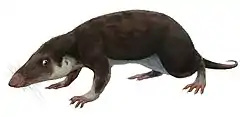Dromatheriidae
Dromatheriidae is an extinct family of prozostrodontian cynodonts, closely related to mammals. Members of the family are known from the Late Triassic (Carnian to Rhaetian) of India,[1] Europe and North America. Apart from a few jaw fragments, dromatheriids are mainly known from their sectorial (flesh-slicing) postcanine teeth. The teeth were fairly typical among early prozostrodontians, as they were labiolingually compressed (flattened sideways), with a single root and crown hosting a longitudinal row of sharp cusps. Dromatheriids in particular have a very narrow and symmetrical crown (when seen from above) without a prominent cingulum (a ridge or array of cuspules adjacent to the main cusps).[1][2][3]
| Dromatheriidae Temporal range: | |
|---|---|
| Scientific classification | |
| Domain: | Eukaryota |
| Kingdom: | Animalia |
| Phylum: | Chordata |
| Clade: | Synapsida |
| Clade: | Therapsida |
| Clade: | Cynodontia |
| Clade: | Prozostrodontia |
| Family: | †Dromatheriidae Gill, 1872 |
| Genera | |
| |
Dromatheriid teeth on average have four main cusps, though some have as few as two (Dromatherium) or three (Tricuspes), or as many as six (Inditherium, Pseudotriconodon). Although the teeth have a single root, a vertical furrow on each side of the root appears to be a trait incipient towards the two fully divided roots of mammaliaforms.[1][3] Making note of this condition, some authors have suggested that dromatheriids are a paraphyletic group ancestral to mammaliaforms.[2] Other studies instead consider the closest relatives of dromatheriids to be the "therioherpetids" Therioherpeton and Meurthodon, which may even be placed within the family.[3] However, the broader cusps of Therioherpeton and the divided root of Meurthodon dissuade their position within Dromatheriidae.[4]
References
- Bhat, Mohd Shafi; Ray, Sanghamitra; Datta, P. M. (2020). "New cynodonts (Therapsida, Eucynodontia) from the Late Triassic of India and their significances". Journal of Paleontology. 95 (2): 376–393. doi:10.1017/jpa.2020.95. S2CID 228836405.
- Godefroit, Pascal; Battail, Bernard (1997). "Late Triassic cynodonts from Saint-Nicolas-de-Port (north-eastern France)" (PDF). Geodiversitas. 19: 567–631. Archived from the original (PDF) on 2018-05-03.
- Sulej, Tomasz; Niedźwiedzki, Grzegorz; Tałanda, Mateusz; Dróżdż, Dawid; Hara, Ewa (2020). "A new early Late Triassic non-mammaliaform eucynodont from Poland". Historical Biology. 32 (1): 80–92. doi:10.1080/08912963.2018.1471477. S2CID 90448333.
- Oliveira, É. V. (2006). "Reevaluation of Therioherpeton cargnini Bonaparte & Barberena, 1975 (Probainognathia, Therioherpetidae) from the Upper Triassic of Brazil" (PDF). Geodiversitas. 28 (3): 447–465.





